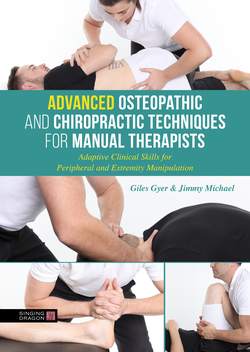Читать книгу Advanced Osteopathic and Chiropractic Techniques for Manual Therapists - Giles Gyer - Страница 9
На сайте Литреса книга снята с продажи.
Modulation of gamma motor neuron activity
ОглавлениеKorr’s (1975) theory of the facilitated segment is a decades-old theory that has been used to interpret the mechanism of manipulation. From the early evidential basis, Korr hypothesised that a painful segment has a facilitatory response, and proposed that an increase in gamma motor neuron activity could lead to muscle hypertonicity by reflexly facilitating the alpha motor neuronal hyperexcitability. Korr suggested that spinal manipulation could calm the excited gamma motor neurons by increasing joint mobility, producing a barrage of proprioceptive afferent impulses. However, one major limitation of Korr’s theory is that it lacked the neural pathways (i.e., afferent input likely to arise and reflex pathways that may be activated due to spinal manipulation) for its proposed mechanism of action. Interestingly, the pain–spasm–pain cycle (Travell et al. 1942) sheds some light on the possible neural pathway that may be involved in gamma motor neuron excitability. Johansson and Sojka (1991) proposed that this neural pathway would involve a hyperactive spinal stretch reflex, which is a process that involves skeletal muscle contraction and is thought to occur when the muscle spindles and Ia afferents are activated due to stretching of the muscle (Trompetto et al. 2014). Johansson and Sojka (1991) postulated that nociceptive afferents directly project on the gamma motor neurons, which react by increasing the output of muscle spindles, allowing the associated afferent nerves to signal changes in muscle length. This, in turn, results in the hyperexcitability of alpha motor neurons and subsequently leads to increased muscle activation.
As stated before, the pain–spasm–pain model is not unequivocally supported in the literature. Several authors have suggested that the sensitivity of muscle spindles is not affected by LBP, or paraspinal tissues do not undergo noxious stimulation (Birznieks, Burton and Macefield 2008; Zedka et al. 1999). Many studies still support the concept that spinal manipulation disrupts the pain–spasm–pain cycle and that it works by decreasing the hyperactivity of underlying nociceptors, consequently leading to stretch reflex attenuation and subsequent reduction in muscle activation (Herzog 2000; Pickar and Bolton 2012; Potter et al. 2005). Recently, however, two novel studies have established that with spinal manipulation, corticospinal or stretch reflex excitability can be attenuated. In the first study done to quantify the effects of spinal manipulation on stretch reflex excitability, Clark et al. (2011) observed an attenuation of stretch reflex of the erector spinae muscles when spinal manipulation produced an audible cracking sound. The authors suggested that manipulation might mechanistically act to reduce the output of muscle spindles and other segmental sites in the Ia reflex pathway. The second study was conducted by Fryer and Pearce (2012) on asymptomatic participants. The authors demonstrated a significant reduction in corticospinal and spinal reflex excitability following HVLAT manipulation that produced an audible cavitation. They also suggested that considerable alterations in corticospinal excitability could lead to changes in motor recruitment strategies.
These findings provide more insight into the possible segmental mechanisms of spinal manipulation. In addition, because an increased stretch reflex gain forms the basis of one of the neural pathways of the pain–spasm–pain cycle, it can be said that spinal manipulation may function via the pain model by attenuating stretch reflex hyperactivity, consequently reducing the hyperexcitability of gamma motor neurons.
